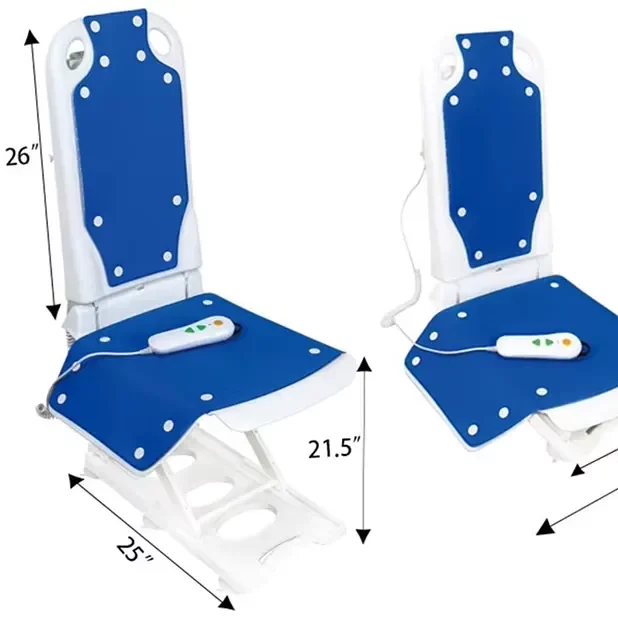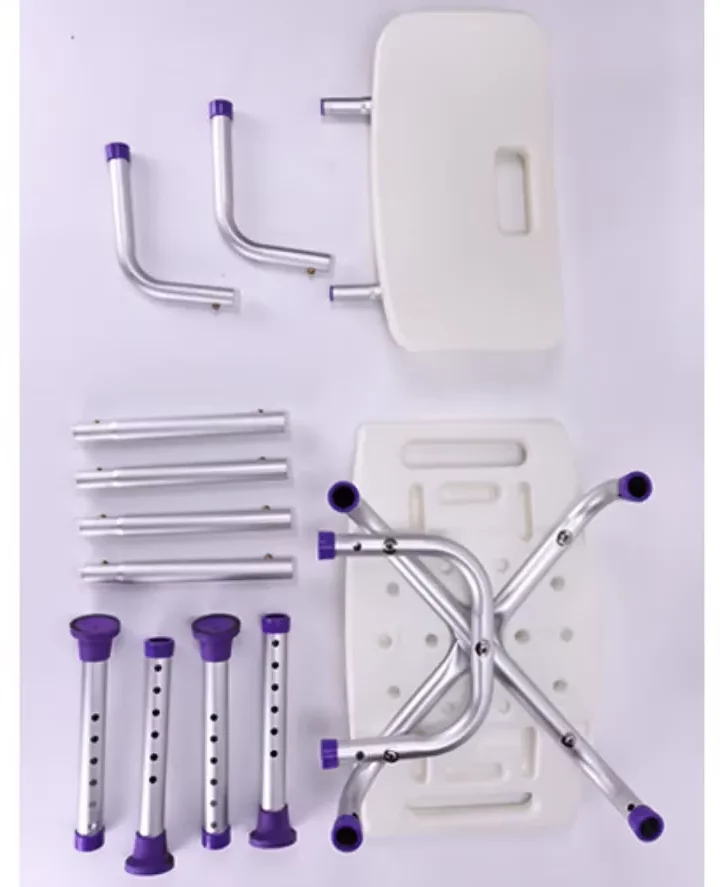There are some daily routines so fundamental we never give them a second thought. But when mobility challenges arise, a simple trip to the bathroom can feel like a daunting odyssey. We’re here to change that.

So, how does a shower commode chair simplify daily living? In short, it’s a versatile 3-in-1 commode that acts as a secure shower seat, a supportive toilet frame, and a convenient bedside commode, effectively promoting dignified personal care and independence.
That’s the quick take. But if you’re looking for a real solution for yourself, a loved one, or your facility, the details matter. Let’s dive deeper into how this single piece of equipment can be a game-changer.
What Exactly Is a Shower Commode Chair?
Let’s clear up any confusion. When we talk about a shower commode chair, we’re not just discussing a simple plastic stool. Think of it as the Swiss Army knife of bathroom safety for seniors. It’s a single, thoughtfully engineered piece of durable medical equipment designed to serve three critical functions:
- A Stable Shower Seat: Its primary role is providing a secure place to sit while showering. A proper padded shower seat on a stable shower seat frame eliminates the exhausting effort of standing and dramatically reduces the risk of slipping on wet surfaces.
- An Over-the-Toilet Commode: You can place it directly over your existing toilet. The arms provide excellent leverage for sitting and standing, making it a superior toilet safety frame. This is a crucial aspect of safe toilet use for disabled individuals.
- A Bedside Commode: For nights when a trip to the bathroom feels like a marathon, it serves as a portable commode toilet right in the bedroom, offering a safe and accessible option.
This all-in-one shower and toilet chair design is what makes it one of the most effective independent living products available.
Benefit #1: Reclaiming Independence and Dignity
I think we can all agree that privacy is a cornerstone of human dignity. Needing assistance with personal tasks like toileting or showering can be emotionally difficult, chipping away at confidence.
This is where the commode chair truly shines. For so many, this chair is the key to reclaiming independence. It’s the tool that allows them to manage personal care on their own terms. The sturdy arms offer the support needed to lower and raise oneself without help. The stable seat in the shower removes the fear that often leads people to ask for assistance.
This isn’t just about physical support; it’s about emotional freedom. It’s about closing the bathroom door with the confidence that you have the right equipment to be safe.
Benefit #2: A Fortress of Safety on Slippery Surfaces
The bathroom is, statistically, one of the most hazardous rooms in the home. The combination of water, smooth surfaces, and physical exertion creates a perfect storm for accidents. A shower commode seat is a foundational element of fall prevention in the bathroom.
Here’s how it creates a safer environment:
- A Solid Base: A well-designed chair has wide-set, rubber-tipped feet that grip the floor, whether it’s tile or the inside of a tub. This creates a stable shower seat that won’t shift or wobble.
- Fewer Transfers: Instead of moving from a walker to the toilet, then to a separate shower stool, a rolling shower chair can serve as your primary transfer chair for elderly and disabled users. This streamlines patient transfer assistance, minimizing the number of times a user has to stand and sit, which is when most falls occur.
- Leverage for Standing: The armrests are crucial leverage points. Pushing up from a seated position becomes a safer, more controlled movement.
These accessibility solutions are essential for aging in place bathroom safety, transforming the bathroom from a source of anxiety into a manageable space.
Benefit #3: Turning a Chore into a Relaxing Routine
If you’re dealing with a post-surgery recovery aid or managing a chronic condition, you know that energy is a precious resource. A simple shower can feel depleting.
A padded shower seat changes that dynamic entirely. It allows you to sit, relax, and enjoy the warm water without the physical strain of standing. By conserving energy during daily routines, you have more left for the things that bring you joy. This is how simple handicap bathroom equipment can genuinely simplify daily living.

The All-in-One Advantage: Why One Chair Beats Three Gadgets
You might wonder, “Can’t I just buy a separate toilet riser, a shower stool, and a bedside pail?” You could, but I’ve seen firsthand why an all-in-one shower and toilet chair is a smarter choice.
| Feature | All-in-One Commode Chair | Three Separate Devices |
|---|---|---|
| Space | One compact footprint. Ideal for smaller bathrooms. | Three bulky items to store and navigate around. |
| Cost | One purchase, often more cost-effective. | Three separate purchases that can add up quickly. |
| Convenience | Seamless transitions. A rolling model moves from toilet to shower. | Clunky process requiring multiple, risky transfers. |
| Simplicity | One item to clean and maintain. | Three items to clean, three sets of potential issues. |
Ultimately, the integrated approach saves space, money, and hassle. It’s a more streamlined solution for both users and caregivers.
What Makes a Great Commode Seat? A Buyer’s Guide
Not all commode chairs are created equal. As with any important piece of patient care equipment, the details make all the difference. Here’s what I tell people to look for.
1. Materials That Last: The Hunt for a Rust-Proof Commode
This chair will live in a wet environment, so one word is non-negotiable: rust-proof. I’ve seen too many chairs made from powder-coated steel that chip and rust, compromising safety and hygiene.
Look for a medical grade shower chair made from high-grade, anodized aluminum or medical-grade polymers. These materials are inherently resistant to corrosion. A rust-proof commode is not a luxury; it’s a fundamental safety requirement that ensures a long service life.
2. Perfect Fit: The Importance of an Adjustable Height Commode Chair
A one-size-fits-all approach doesn’t work for something this personal. An adjustable height commode chair is essential. Look for push-pin mechanisms that allow for easy height changes. The ideal height lets the user’s feet rest flat on the floor with their knees at a 90-degree angle, making it much easier and safer to stand up.
3. Comfort and Hygiene: Padded and Easy-to-Clean Designs
Comfort is key. A hard plastic seat can be unforgiving. A high-quality padded shower seat, often made from closed-cell foam, provides cushioning without absorbing water, which is crucial for preventing mold.
Equally important is an easy to clean commode. Look for:
- Smooth Surfaces: Fewer nooks and crannies for germs.
- Removable Components: The seat, lid, and pail should be easy to remove for thorough cleaning.
- Non-Porous Plastics: These won’t stain or retain odors.
For any shared environment, like in assisted living supplies or nursing home equipment, impeccable hygiene is paramount.

4. Mobility: To Roll or Not to Roll?
This is a key decision. Do you need a stationary chair or one with wheels?
- Stationary Chairs: Excellent for users who can still walk but need support at the toilet or in the shower.
- Rolling Shower Chairs: A shower chair with wheels is a game-changer for users with significant mobility issues. It streamlines patient transfer assistance, allowing a caregiver to wheel the user from the bedroom directly into a roll-in shower.
If you opt for a rolling model, ensure the casters have reliable, easy-to-use locking brakes on at least two wheels.
A Note for Caregivers: Reducing Strain and Preventing Injury
To all the caregivers: we see you. Your work is physically demanding. The right caregiver support aids are as much for you as they are for the person you care for.
A shower commode chair dramatically reduces the physical load on your back and shoulders. Instead of performing difficult lifts in a cramped, wet bathroom, you are guiding and stabilizing. This focus on reducing caregiver strain lowers your risk of injury, allowing you to provide better, safer care for longer.
For Professionals: A Message to Procurement Managers
If you’re in healthcare procurement or a medical equipment distributor, you’re looking at this through a different lens: budget, durability, compliance, and patient satisfaction.
As someone who works with factories like Ary Medical, I understand the B2B landscape. You need hospital grade commode chairs that work, last, and meet all standards.
When evaluating a DME supplier for wholesale medical chairs, here’s what matters:
- Certifications: Is the product a CE certified commode? Is it an FDA registered medical device? These are your assurance of quality and safety compliance.
- Durability & ROI: A heavy-duty bariatric commode or a standard model made from rust-proof aluminum will have a lower total cost of ownership than cheaper alternatives. Durability is key in high-use environments.
- Patient Outcomes: High-quality elderly care products directly impact resident satisfaction and facility reputation.
- Supplier Reliability: You need a partner who can deliver consistently, offer customization, and stand behind their product. A stable supply chain is non-negotiable.
Your Top Questions, Answered
Q: How much weight can these chairs typically support? Standard models support 250-300 lbs (113-136 kg). For larger individuals, it’s crucial to select a heavy-duty bariatric commode, which can often support 500 lbs (227 kg) or more. Always check the manufacturer’s specified weight capacity.
Q: Are they difficult to assemble? Most modern designs feature tool-free assembly. Parts snap together securely in minutes. You should be able to set it up in under 15 minutes.
Q: What’s the best way to clean and maintain one? Clean it regularly with a mild bathroom cleaner. For disinfection, use hospital-grade wipes or a diluted bleach solution (check manufacturer guidelines). After showering, wipe the frame dry to prevent mineral buildup. Regularly check that all pins are secure and wheels are in good condition.
Final Thoughts: More Than Just a Chair
At the end of the day, a shower commode chair is made of aluminum and plastic, but its true value is measured in renewed confidence, in moments of privacy, and in the peace of mind that comes from knowing you or your loved one is safe.
It’s a simple tool that enables aging in place bathroom safety and restores a fundamental part of daily life. It’s not just a piece of home health care supplies; it’s a bridge to greater independence.
[Editor’s Note]
- Authenticity is Key: This post ranks by being more than just a product description. Using a personal, empathetic tone (“I’ve seen…”, “I think we can all agree…”) builds trust. The content addresses the emotional needs (dignity, independence) behind the physical need for the product.
- Comprehensive Keyword Integration: The success of this article lies in its natural integration of a wide range of LSI keywords. It covers the topic from multiple angles: the user ( independent living products ), the caregiver ( reducing caregiver strain ), and the professional buyer ( healthcare procurement , CE certified commode ). This signals to search engines that this is a thorough, expert resource.
- Clear Structure & Scannability: The use of clear H2/H3 headings, a comparison table, bullet points, and a mini-FAQ makes the content highly scannable. Busy readers can find their answers quickly, while others can dive deep. The “quick take” at the top is crucial for capturing attention immediately.
- Targeted Content: The “For Professionals” section is a strategic addition. By speaking directly to a B2B buyer persona, the post opens up a new avenue for relevance and authority, especially for a manufacturer like Ary Medical.
